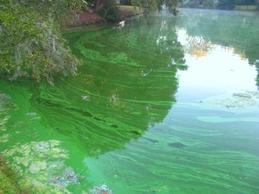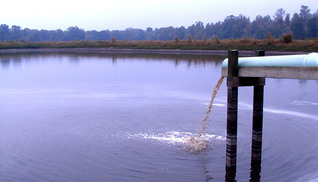 Cyanobacteria Bloom
Cyanobacteria Bloom While algae is important for normal pond activity. Excessive nutrients and summer temperatures can lead to a cyanobacteria bloom. These "algae" are actually a photosynthetic bacteria. They tend to form a bright green, blue-green surface scum and increase suspended solids in the pond. Besides causing problems with effluent TSS, cyanobacteria produce chemicals that contribute to odors and off-flavors in ponds. If the bloom is substantial, cyanobacteria can also prove deadly to wildlife. In 2013, an elk herd in New Mexico drank from a pond with a cyanobacteria bloom and was found dead in the immediate vicinity.
 Note foam & slight film on surface
Note foam & slight film on surface 
 RSS Feed
RSS Feed